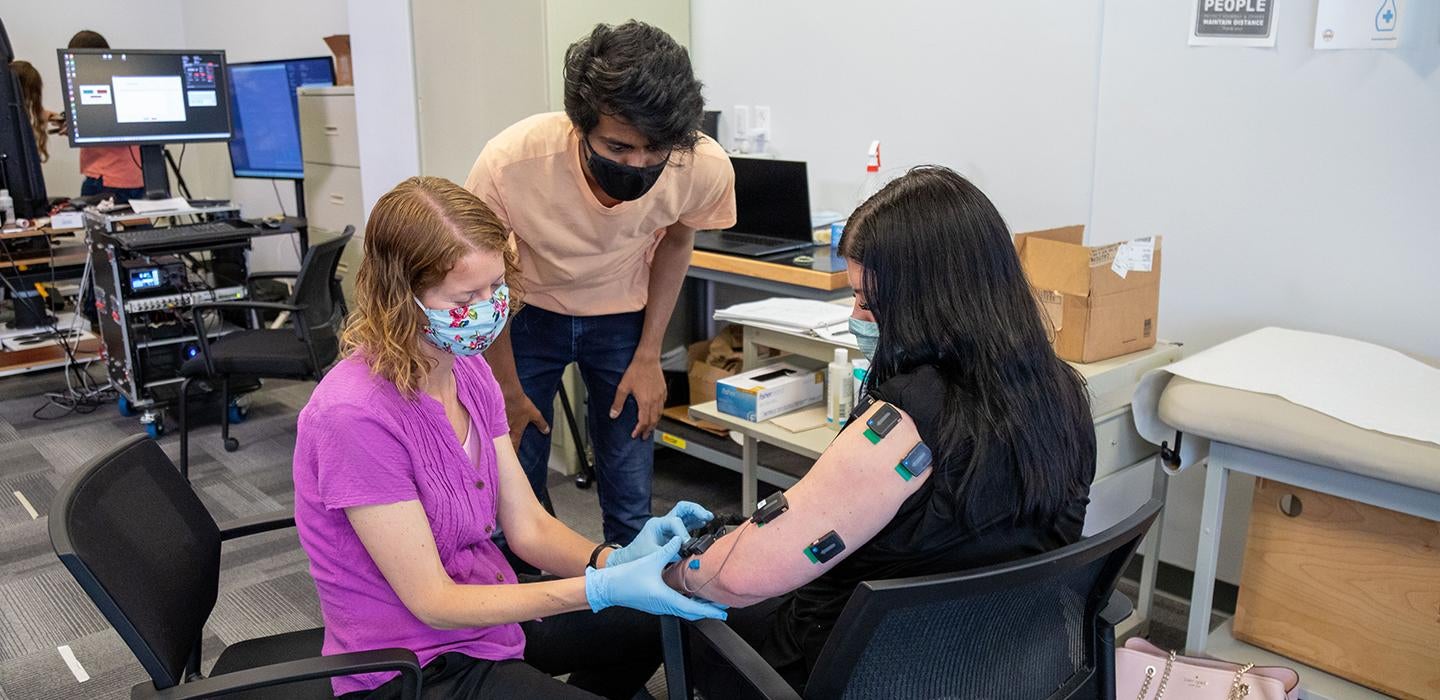
Subscribe to Pittwire Today
Get the most interesting and important stories from the University of Pittsburgh.A new study from Pitt and Carnegie Mellon University shows it’s possible to restore long-lost hand motion in stroke patients using a spinal cord implant. Though preliminary, the research has the potential to help those with an impairment that’s currently considered permanent — and leading the charge were Pitt PhD students.
“Millions of people have strokes, and of those people, the majority have some form of paralysis,” said Erynn Sorensen, a co-lead author of the paper and a PhD student in Pitt’s Rehab Neural Engineering Labs (RNEL). “There is a huge need for a technology like this. People want to be able to interact with the world around them.”
No other treatment exists for regaining hand movement in the “chronic” stage of stroke, six or more months after the stroke incident. To accomplish this feat, the researchers implanted electrodes in the necks of two patients, which when activated deliver electric charges to specific locations along the spinal cord. Those bursts of electricity then allow patients to accomplish desired movements, such as picking up a can of soup.
The team’s research comes after years of study from the group on the approach, both modeling using computers and testing in animals. Though the technology is already in use for other purposes, this is the first demonstration of its effectiveness for regaining hand motion after stroke in people. After publishing Feb. 20 in the journal Nature Medicine, the research has been featured in the The New York Times, The Associated Press, CNN and a wide variety of other outlets.
It's a preliminary study with a small number of patients, and the effect ends after the stimulation is over — but the device, Sorensen explained, allows patients to regain a measure of agency over their movement instantly.
“It’s the person doing what they want to do as they want to do it, as opposed to something external doing it for them,” said Sorensen, who is advised by the paper’s senior author and Department of Medicine Assistant Professor Marco Capogrosso. “This is a really simple solution in the scope of things: It just provides a base level of support.”
Sorensen joined the lab to merge her prior neuroscience experience with a more clinical approach, and she’s now one of several graduate students who’ve taken leading roles on the project. While each has a particular area of research they specialize in, the day-to-day operation of the project is highly collaborative.
Along with her research focus on testing whether the device helps patients with their movements, Sorensen and the other graduate students take an active role in working with patients, a task that often keeps them in the lab four or five hours each day over the course of a month. “I’m responsible for making sure that’s all set up and helping to run that experiment and keep it coordinated,” said Sorensen.
Another student co-author of the paper is Erick Carranza, who came to Pitt from Peru in 2019 with a background in robotic devices and automation. His desire to pursue an academic path where he could help people with disabilities led him to RNEL, where he’s advised by Research Assistant Professor Elvira Pirondini in the School of Medicine.
Carranza’s main role on the project was developing and assessing tasks where patients used a KINARM, an exoskeleton that supports the patient’s arm. “The fact that they have to move against gravity makes it really hard to develop 3D motions,” said Carranza. “The KINARM offers support, allowing them to perform smoother movements and compensate for gravity.”
Each patient’s disability is distinct, so developing appropriate tasks for them to attempt can take days of fine-tuning. “We customize the task to each patient’s limitations and try to challenge the patient to do things they can’t normally do,” to see whether stimulation can help them perform the tasks normally, he said.
For Carranza, the project has reaffirmed his desire to work at a company that uses technology to help patients with strokes or other neurological diseases.
“I have never seen a technology before that makes such a big difference in such a short period of time,” he said. “If I can do this for the rest of my life, that would be so cool.”
— Patrick Monahan, with materials from UPMC. Photography by Tim Betler, UPMC/Pitt Health Sciences


